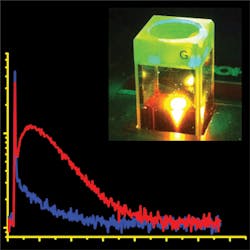PHOTODYNAMIC THERAPY/ONCOLOGY: Photon-counting nanowires promise precision photodynamic cancer therapy
As described in a study published by Optics Express, a team of researchers from Scotland, Canada, and The Netherlands have reached a milestone in optical monitoring for medical applications.1 The milestone involves the excited state of the oxygen molecule, commonly referred to as singlet oxygen, which is a crucial intermediate step in many biological and physiological processes.
Singlet oxygen is, for instance, generated by a laser-activated photosensitizer drug during photodynamic therapy (PDT), a growing application area for photonic technologies in medicine. In the treatment of cancer, singlet oxygen produces tumor cell death. But accurate dosimetry for PDT is extremely important—and highly challenging. According to the researchers, the detection of singlet oxygen luminescence (occurring at 1270 nm wavelength) provides a direct route towards PDT dosimetry.
To read singlet oxygen luminescence with unprecedented signal-to-noise ratio, the team used advanced infrared single-photon detection technology.2 The superconducting nanowire detector is fiber-coupled and housed in a practical closed-cycle refrigerator. According to Nathan Gemmell, the PhD research student who performed the experiments at Heriot-Watt University (Edinburgh, Scotland), "the exceptional performance of our superconducting detector allowed us to make measurements for the first time using an optical fiber to pick up the light from the decay of the excited oxygen molecules."
According to Professor Brian Wilson of the Ontario Cancer Institute (Toronto, Canada), "the ability to perform these measurements is a marked step forward for this field." He explains that the optical fiber offers a tremendous practical advantage that in the future will allow dose monitoring to be performed locally within tumors. This means the possibility of accurate "on-line" control during treatment to ensure the highest tumor kill without damaging normal, healthy tissues.
1. N. R. Gemmell et al., Opt. Exp., 21, 4, 5005–5013 (2013).
2. C. M. Natarajan et al., Supercond. Sci. Technol., 25, 063001 (2012); doi:10.1088/0953-2048/25/6/063001.

